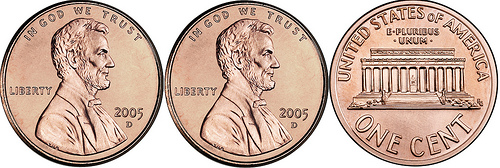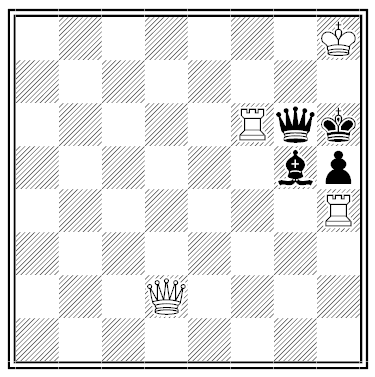misopedia
n. dislike of children
Run Toppers

Let’s play a game. We’ll each name three consecutive outcomes of a coin toss (for example, tails-heads-heads, or THH). Then we’ll flip a coin repeatedly until one of our chosen runs appears. That player wins.
Is there any strategy you can take to improve your chance of beating me? Strangely, there is. When I’ve named my triplet (say, HTH), take the complement of the center symbol and add it to the beginning, and then discard the last symbol (here yielding HHT). This new triplet will be more likely to appear than mine.
The remarkable thing is that this always works. No matter what triplet I pick, this method will always produce a triplet that is more likely to appear than mine. It was discovered by Barry Wolk of the University of Manitoba, building on a discovery by Walter Penney.
“French for Americans”
Phrases most in demand by American visitors to Paris, compiled by Robert Benchley:
Pronunciation:
a = ong
e = ong
i = ong
o = ong
u = ong
Haven’t you got any griddle-cakes?
N’avez-vous pas des griddle-cakes?
What kind of a dump is this, anyhow?
Quelle espèce de dump is this, anyhow?
Do you call that coffee?
Appelez-vous cela coffee?
Where can I get a copy of the N.Y. Times?
Où est le N.Y. Times?
What’s the matter? Don’t you understand English?
What’s the matter? Don’t you understand English?
Of all the godam countries I ever saw.
De tous les pays godams que j’ai vu.
I haven’t seen a good-looking woman yet.
Je n’ai pas vu une belle femme jusqu’à présent.
Here is where we used to come when I was here during the War.
Ici est où nous used to come quand j’étais ici pendant la guerre.
Say, this is real beer all right!
Say, ceci est de la bière vrai!
Oh boy!
O boy!
Two weeks from tomorrow we sail for home.
Deux semaines from tomorrow nous sail for home.
Then when we land I’ll go straight to Childs and get a cup of coffee and a glass of ice-water.
Sogleich wir zu hause sind, geh ich zum Childs und eine tasse kaffee und ein glass eiswasser kaufen.
“Word you will have little use for”:
Vernisser — to varnish, glaze.
Nuque — nape (of the neck).
Egriser — to grind diamonds.
Dromer — to make one’s neck stiff from working at a sewing machine.
Rossignol — nightingale, picklock.
Ganache — lower jaw of a horse.
Serin — canary bird.
Pardon — I beg your pardon.
The Airy Box
It’s said that British Astronomer Royal G.B. Airy once discovered an empty box at the Greenwich Observatory in London.
He wrote EMPTY BOX on a piece of paper and put it inside.
“Attached to the outside, such a label is true,” write Gary Hayden and Michael Picard in This Book Does Not Exist. “Placed inside the box, it makes itself false. Alternatively, suppose the label says: ‘The box this label is inside is empty.’ Outside of any box, the subject of this sentence fails to refer — there is no box inside which the label is located. However, once inside an otherwise empty box, the sentence becomes false.”
Two Logos in One

The New Zealand property management company Emma Sammes has a curious claim to fame — if its name is laid out in a circle, it can be read both clockwise and counterclockwise.
British actress Emma Samms can almost claim the same distinction — but for one E.
Faith and Sugar
A placebo has no pharmaceutical properties; if it works, it works only because of my own belief in its efficacy.
If I know that I’m taking a placebo, it will be ineffective.
So while the placebo cures me only because I believe it will, I can’t believe that it will cure me only because I believe it will.
(From City University philosopher Peter Cave.)
Scene

In 1954, at his wife’s urging, vice president Richard Nixon wrote on a slip of paper:
“I promise to Patricia Ryan Nixon that I will not again seek public office.”
He dated the note, folded it, and put it in his wallet.
Six years later he ran for president.
The Last Redoubt
“Today Is Yesterday’s Pupil”
The 17th-century churchman Thomas Fuller (1608-1661) had a gift for pithy maxims:
- Every horse thinks its own pack heaviest.
- There is more pleasure in loving than in being beloved.
- He that has a great nose, thinks everybody is speaking of it.
- It is more difficult to praise rightly than to blame.
- Eaten bread is forgotten.
- A wise man may look ridiculous in the company of fools.
- Bad excuses are worse than none.
- A book that is shut is but a block.
- Custom is the plague of wise men and the idol of fools.
- A man is not good or bad for one action.
- Unseasonable kindness gets no thanks.
- ‘Tis skill, not strength, that governs a ship.
- Abused patience turns to fury.
- All things are difficult before they are easy.
- Poor men’s reasons are not heard.
- The more wit the less courage.
- Travel makes a wise man better, and a fool worse.
And “Learning hath gained most by those books by which the printers have lost.” “Wit,” wrote Coleridge, “was the stuff and substance of Fuller’s intellect.”
Pull!

Bicycles are great for exercising the lower body, but what about the back? In 1900 Louis S. Burbank had a bright idea — by mounting a pair of sculls on the frame, the modern cyclist can row his way to total fitness.
The levers are used for both pedaling and steering. The patent says nothing about brakes.

